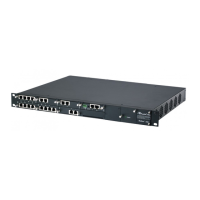SIP User's Manual 612 Document #: LTRT-83310
Mediant 600 & Mediant 1000
Parameter Description
[1] = Use Transparent coder for data calls (according to RFC
4040).
The Transparent' coder can be used on data calls. When the device
receives a Setup message from the ISDN with 'TransferCapabilities =
data', it can initiate a call using the coder 'Transparent' (even if the
coder is not included in the coder list).
The initiated INVITE includes the following SDP attribute:
a=rtpmap:97 CLEARMODE/8000
The default payload type is set according to the CodersGroup
parameter. If the Transparent coder is not defined, the default value is
set to 56. The payload type is negotiated with the remote side, i.e.,
the selected payload type is according to the remote side selection.
The receiving device must include the 'Transparent' coder in its coder
list.
Web: Enable IP2IP
Application
[EnableIP2IPApplication]
Enables the IP-to-IP Call Routing application.
[0] Disable (default)
[1] Enable
Note: For this parameter to take effect, a device reset is required.
[IP2IPTranscodingMode]
Defines the voice transcoding mode (media negotiation) between two
user agents for the IP-to-IP application.
[0] Only if Required = Do not force transcoding. Many of the media
settings (such as gain control) are not implemented on the voice
stream. The device passes packets RTP to RTP packets without
any processing.
[1] Force = Force transcoding on the outgoing IP leg. The device
interworks the media by implementing DSP transcoding. (default)
Web: Enable RFC 4117
Transcoding
[EnableRFC4117Transcodi
ng]
Enables transcoding of calls according to RFC 4117.
[0] Disable (default)
[1] Enable
Notes:
For this parameter to take effect, a device reset is required.
For more information on transcoding, see Transcoding using
Third-Party Call Control on page 473.
Web/EMS: Default Release
Cause
[DefaultReleaseCause]
Defines the default Release Cause (sent to IP) for IP-to-Tel calls
when the device initiates a call release and an explicit matching
cause for this release is not found.
The default release cause is NO_ROUTE_TO_DESTINATION (3).
Other common values include NO_CIRCUIT_AVAILABLE (34),
DESTINATION_OUT_OF_ORDER (27), etc.
Notes:
The default release cause is described in the Q.931 notation and
is translated to corresponding SIP 40x or 50x values (e.g., 3 to SIP
404, and 34 to SIP 503).
For analog interfaces: For information on mapping PSTN release
causes to SIP responses, see Mapping PSTN Release Cause to
SIP Response on page 282.
When the Trunk is disconnected or is not synchronized, the
internal cause is 27. This cause is mapped, by default, to SIP 502.
For mapping SIP-to-Q.931 and Q.931-to-SIP release causes, see
Configuring Release Cause Mapping on page 267.
For a list of SIP responses-Q.931 release cause mapping, see

